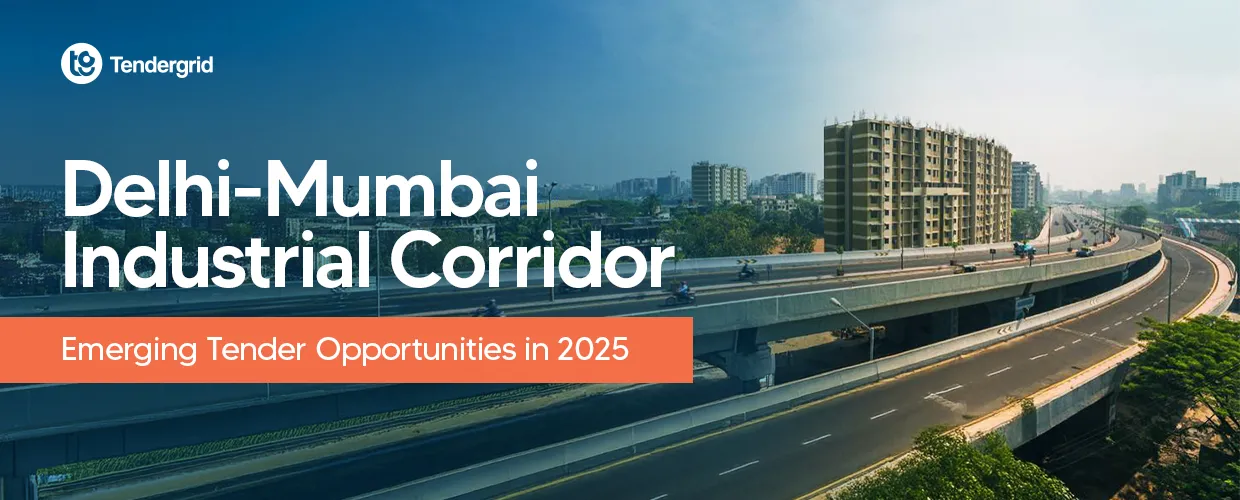Recently a speedy transformation has been observed in India's infrastructure ecosystem. Delhi-Mumbai Industrial Corridor (DMIC), is one of those. Intended to develop a world-class industrial region across six Indian states, it is considered as a mega project. With 2025 set to be a fast-paced year for the corridor, fresh business opportunities are unfolding, especially in government tendering. No matter you are an engineering consultant, construction company, technology supplier, or urban infrastructure developer, the DMIC offers a vast pool of untapped opportunities.
Let's explore how 2025 will reshape India's tendering space through DMIC initiatives. Also discover how platforms like Tender Grid are making such opportunities easier to access than ever before.
DMIC: A Vision That Redefines Industrial India
The Delhi-Mumbai Industrial Corridor is crucial for India's development in future. It has been initiated in order to connect Mumbai (financial capital), with Delhi (political capital). The DMIC spreads over 1,500 kilometers, which includes six states, Delhi, Uttar Pradesh, Haryana, Rajasthan, Gujarat, and Maharashtra.
The corridor has been conceptualized as a technologically advanced industrial corridor. It consists of a combination of smart cities, logistics parks, freight corridors, and green infrastructure. Supported by strategic cooperation between the Government of India and Japan, the DMIC is also in line with the Make in India initiative with the goal of increasing domestic manufacturing and exports.
What makes DMIC unique is its integrated method: it combines infrastructure, town planning, technology, and administration, forming a system that is open to domestic as well as foreign investors. As all these projects start shifting from drawing board to realization in 2025, the potential of DMIC Tenders will multiply manifold.
Key DMIC Projects Progressing in 2025
2025 is a make-or-break year for DMIC's development cycle, with several mega-projects at the execution or tender-ready stage. Among the most influential developments are:
1. Dholera Special Investment Region (Gujarat)
Also called India's first greenfield smart city, Dholera will be bigger than Singapore in terms of land size. With core infrastructure almost in place, future tenders will be for the expansion of utilities, roads, water management, and digital services.
2. Shendra-Bidkin Industrial Area (Maharashtra)
This industrial area is becoming more focused due to its connectivity with Aurangabad and alignment with the Western Dedicated Freight Corridor (DFC). Future opportunities are Roads and Highways Tenders, public utility construction, and Construction Engineering Consultancy Tenders.
3. Integrated Industrial Township, Greater Noida (Uttar Pradesh)
Being an electronics and manufacturing hub, this project will be inviting tenders for power supply systems, effluent treatment plants, and urban housing infrastructure.
These projects in total account for more than $100 billion of investment, and their need for infrastructure development is directly translating into profitable DMIC Tenders in 2025.
Emerging Tender Categories in 2025
DMIC in itself is very unique. Various verticals have been included in this, such as transportation, urban planning, logistics, utilities, and IT. This makes its tender categories equally diverse. Here's a breakdown of the emerging tender categories expected to dominate in 2025:
1. Infrastructure Development Tenders
Includes construction of roads, bridges, highways, industrial plots, and townships. These will fall under Roads and Highways Tenders, which are crucial to the corridor’s connectivity mission.
2. Engineering & Consultancy Tenders
From detailed project reports (DPRs) to structural design and urban master planning, Construction Engineering Consultancy Tenders are essential to DMIC’s foundation. These tenders offer excellent opportunities for civil engineering firms, architects, and consultancy agencies.
3. Utility and Environmental Services Tenders
These tenders represent the core to the "smart city" vision. Tenders related to water supply, power distribution, smart metering, sewage treatment, and waste management are covered under these.
4. Technology and Smart Infrastructure Tenders
Cities and areas developed under DMIC are set to incorporate ICT-based solutions for modern-day problems. It covers traffic management, surveillance, digital kiosks, and centralized control centres, which help in opening doors for IT firms and related specialists.
5. Renewable Energy Tenders
Nowadays, maintaining sustainability standards is at peak. In this area multiple opportunities in solar parks, wind energy systems, and energy-efficient building materials, are expected.
If entrepreneurs and companies want to stay ahead in this landscape, they should closely track the emerging categories. Such businesses should be ready to respond to tender calls as soon as they are announced.
Tender Grid: Your Gateway to DMIC Tendering Success
Since there are a lot of opportunities here, navigating the public procurement system can be a complex process. Tender Grid, a specialized e-procurement and tender discovery platform, plays a transformative role, and helps you n such situations.
How Tender Grid Helps:
- Real-Time Alerts: Stay updated on newly published DMIC Tenders, categorized by industry and location.
- Filter by Category: Easily access Construction Engineering Consultancy Tenders, Roads and Highways Tenders, utility works, or IT services.
- Documentation Support: Get help understanding eligibility criteria and technical requirements.
- AI-Powered Insights: Real-time data powered by AI and machine learning.
By simplifying the tender discovery and application process, Tender Grid empowers businesses to tap into high-value government contracts without getting into the hassle of bureaucratic complexity.
Challenges in Bidding for DMIC Tenders – And How to Overcome Them
While the DMIC offers a promising gateway to growth, it also brings a fair share of challenges for bidders:
1. Stringent Eligibility Norms
In most of the tenders specific eligibility norms are required. These can be related to financial turnover, technical expertise, or related certifications. However, preparing the documents, including ISO certifications, past work references, and audited balance sheets, in advance is a complex task.
2. High Competition
Most of the times small companies lag behind in the expertise and experience, when it comes to competing for the same tenders with the large multinational companies. This gap can be filled with niche specializations and expertise. This helps small companies by offering competitive advantages in subcontracts or consortium.
3. Legal and Regulatory Compliance
It can be crucial for SMEs to abide by the tender terms, security deposit rules, and government procurement regulations.
4. Geographical and Logistical Constraints
The DMIC mostly covers remote and developing regions, which is why firms should be prepared for on-site logistical planning and workforce mobilization.
If these challenges are anticipated, then businesses can equip themselves with the right tools. Through this, businesses can win and deliver successfully on DMIC Tenders.
Looking Beyond 2025: DMIC's Long-Term Promise
The year 2025 is not the finish line, it’s the launchpad for DMIC’s next chapter. As the initial phases of the project stabilize, a new wave of tenders will emerge in:
- Affordable housing and real estate development
- Green energy zones
- High-speed rail links and multi modal logistics parks
- AI-powered public governance tools
It has been anticipated that the DMIC will be a global industrial powerhouse. In the coming years, it can contribute in around 25% of India’s GDP growth.
Conclusion
The Delhi-Mumbai Industrial Corridor stands as a beacon of India’s developmental aspirations. It is connecting cities, powering industries, and creating millions of jobs. DMIC Tenders are expected to increase across sectors, in the year 2025. It is unlocking new opportunities in construction, engineering, utilities, and technology.
For companies aiming to enter this dynamic ecosystem, now is the time to get tender-ready. Tender Grid like platforms help in providing easy access to specified opportunities in various sectors including, Construction Engineering Consultancy Tenders, Roads and Highways Tenders, and more.
DMIC represents as a movement which is bringing positive changes for high level as well as SME businesses. Be part of it. Tap into the pool of opportunity, because the future is being built now.

